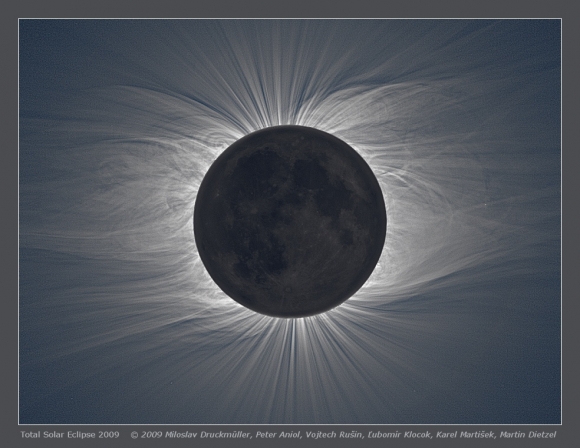These spectacular composite images show the Sun’s corona in all its glory
posted Friday, May 10, 2013 at 2:04 PM EST

Photographing stellar objects from the ground is never an easy task — but when it works, the results can be astonishing and dramatic. Miloslav Druckmüller of the Institute of Mathematics, Faculty of Mechanical Engineering at Brno University of Technology, Czech Republic took a series of photos of a solar eclipse in 2009, and combined them into some of the most astonishing photographs of the Sun's corona we've ever seen.
Druckmüller's images were taken from the remote Marshall Islands in the Pacific Ocean as part of an expedition to measure data from various places around the globe during an eclipse. He took hundreds of photos using Canon cameras, through various lenses and telescopes, and then combined them to create the possible final image.
The image below, for instance, was combined from 31 photographs taken with a Canon 5D, and a 965mm equivalent lens system (William Optics Megrez 88 Doublet FD + Baader Flat-field FFC), which were calibrated and added together. On his website, Druckmüller says:
"80 eclipse images were taken during totality by means of a Canon EOS 5D digital camera equipped with approx. 1 m focal length lens. Unfortunately a lot of images were influenced by clouds and that is why the composition of all images in one resulting image was impossible. Finally 31 images were chosen. About 550 other images (dark frames and flat-fields) were used for eclipse images calibration. The resulting image shows not only the inner corona in the delicate details but also the lunar surface is recorded in a quality not very far from an image taken during the full moon."
At the top of page is another example of his photographs taken during the same eclipse, but at a much wider angle. That single image is a composite of nine images captured with a 200mm lens and 38 images taken with 500 mm lens, all from a Canon 5D.
By getting so far away from any possible light pollution, and by expertly combining a series of images like this, Druckmüller was able to create stunning photographs. You can see more of his photographs from the expedition here, as well as his other eclipse photographs.

(via Colossal)